Anyone who relies on wood heat for the winter, will understand the need to split wood for their wood stove or other heat equipment. The wood should be split to a size that is easy to fit into the stove and it should be dry enough that it is easy to catch fire.
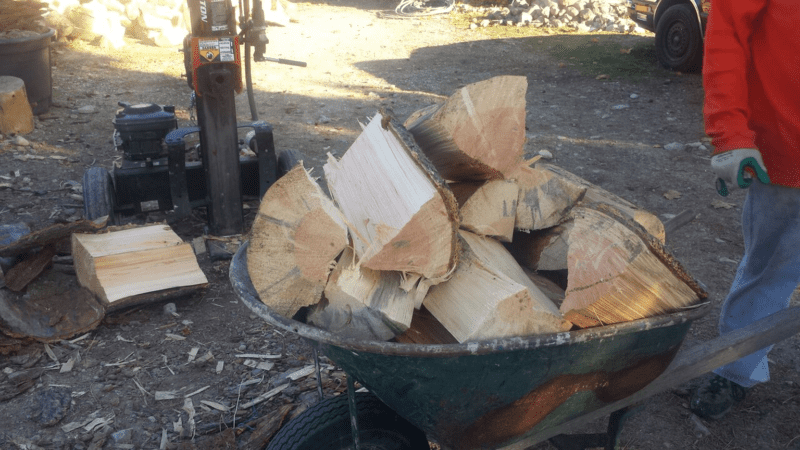
Using An Ax To Split Wood
For centuries, an ax and a maul were the only ways to split wood. People would take a large round of wood, stand another piece of wood a top of the round and use the ax and or the maul to manually split the piece of wood into smaller pieces.
If you don’t have a lot of wood to split, this isn’t too big of an issue, however, if you have a lot of wood to split, it’s going to take a lot of time and it can be painful on your shoulders when you’re swinging the ax or maul. It can take several “hits” from the maul or ax to break a piece of wood into smaller sizes.
Step by step this is how you split wood with an ax or a maul
A maul is heavier than an ax and the head is wider so it tends to split wood easier. However, an ax will do just as well for smaller pieces of wood that need to be split. Keep in mind that you’re splitting wood not cutting it so you don’t need to have a sharp object to accomplish the job.
Your wood should be seasoned as it will split better. If you have to split it green, you can still split it however, it may take a bit more effort.
Check wood for nails before splitting, if there are nails, set the wood aside, it’s not worth damaging yourself, your maul or your ax.
Wood that is being split should have a flat bottom and it shouldn’t have any knots or limbs that wouldn’t easily split.
Follow the lines on the wood when splitting for best results. The wood is defined by grains and will be easier to split if you follow the grain.
If you’re using a chopping block (essentially a larger sized round that you place the wood on to split it) stand your piece of wood on the chopping block. Stand so that you can swing your arms straight down with the blade of the maul or ax hitting the wood along the grain for best results.
Raise the maul or ax over your head and swing it up and straight forward hitting the wood with all your momentum. Let the weight of the maul or ax split the wood, not your strength.
Try to hit the same area of the wood each time you bring the maul or ax down for best results. If you can’t, don’t stress, you’ll get the hang of it and as the wood is continuously hit, it will eventually split. You’ll hear it crack and in short order you’ll have a nicely split piece of wood.
At this point, many simply split the wood into two halves or a few more. The smaller you split the wood the more you can use it to start a fire. It’s all up to you how small you split the wood.
Continue in this fashion until you have as much wood split as desired. Many homesteaders will do this once per day, others prefer to do it for a few days and have a nice stack of split wood for their wood stove. It’s all up to you.
Always make sure that no one is standing too close to you or the wood when you’re splitting wood. Shards of wood can fly and injure someone’s eye or slice into their body if you’re not careful.
Avoid slipping with the maul or ax and injuring yourself. Stand with your legs slightly spread and balanced before hitting the wood with the maul or ax.
Wood Splitter
There are many ways to split wood but the easiest way to do so, is with a wood splitter. There are several varieties of wood splitters on the market today.
You can choose the model that best suits your needs, or as many homesteaders do, borrow one from a neighbor, or go in on a good model with a neighbor so that you can all use it when needed. A wood splitter is far faster to split wood than the old fashioned ax or maul method.
Serious injuries can occur when splitting wood including amputations and death. Read everything carefully prior to operating your wood splitter. Keep your personal safety and that of your friends, family, and pets in mind at all times when operating your wood splitter.
Understanding Your Wood Splitter
Before you begin to split wood there are some things that you’ll want to know and understand about wood splitters.
These are essentially a maul that has been attached to a machine and will split the wood for you by pressure. The round of wood is placed so that it’s underneath of or in front of the maul. Most wood splitters work both horizontally and vertically.
We’ve found that using our wood splitter vertically is the easiest method for us. That way, if the rounds are heavy we can just roll them to the splitter and stand them upright, as opposed to lifting a heavy round onto the flat part of the splitter when it is in the horizontal position.
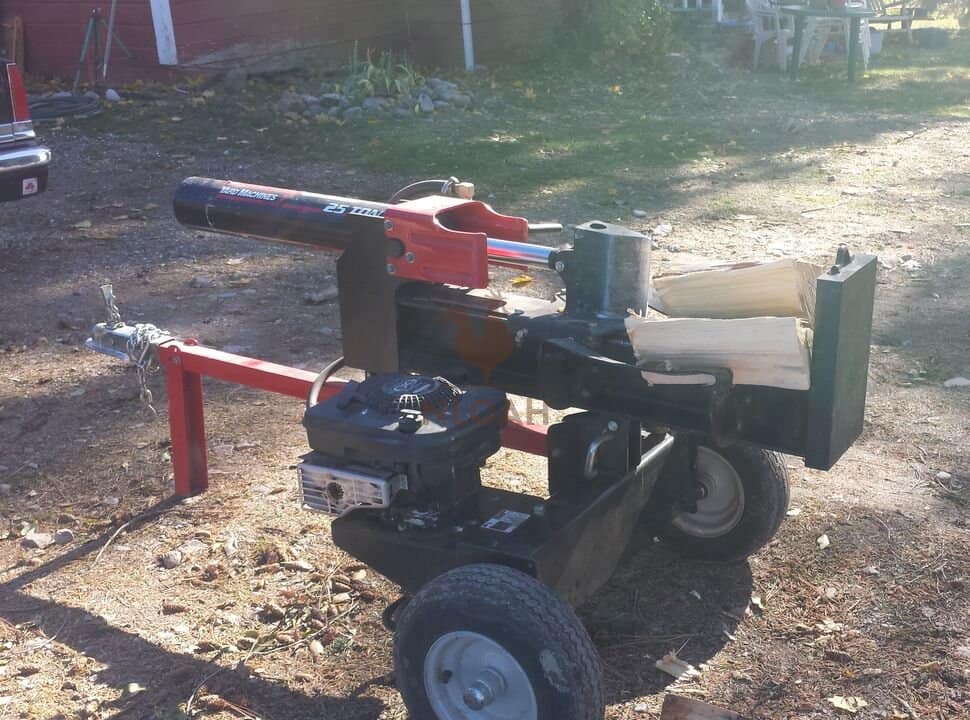
We then center the piece of wood underneath of the maul part of the wood splitter and manually move the lever so that the maul begins to descend onto the round of wood.
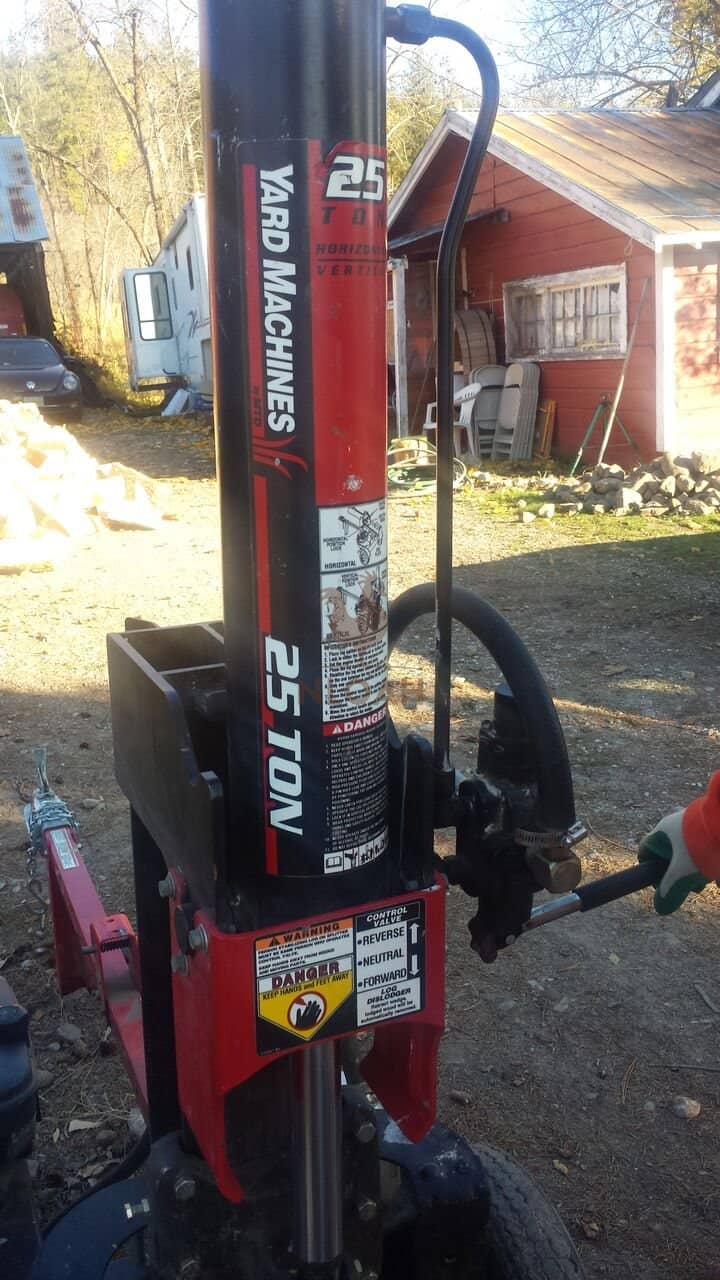
As the maul connects with the round of wood it exerts pressure on the wood forcing it to split. You can then rotate the round so that it is split in several different locations and you’ll be able to adjust how large or small to split your wood. You can even split it into kindling size if desired.
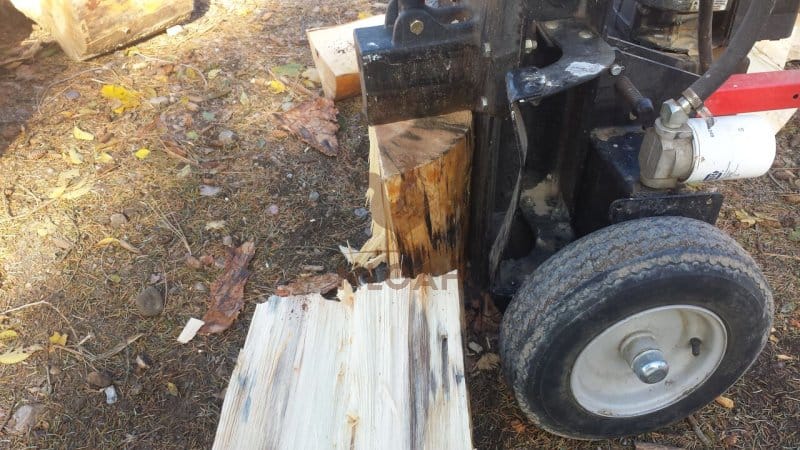
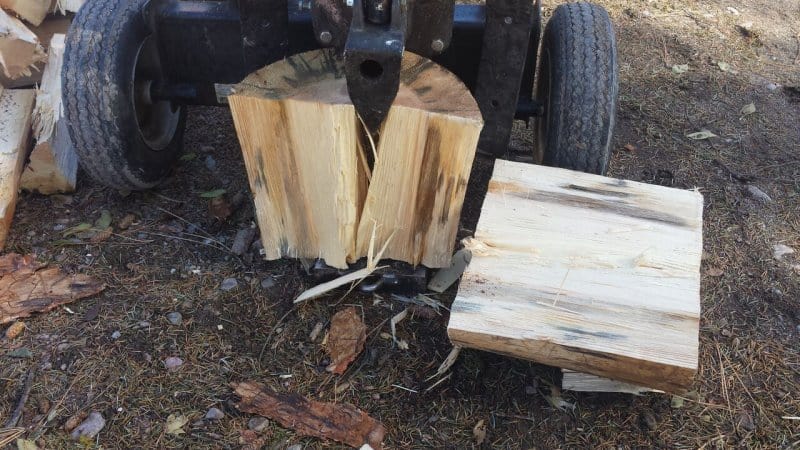
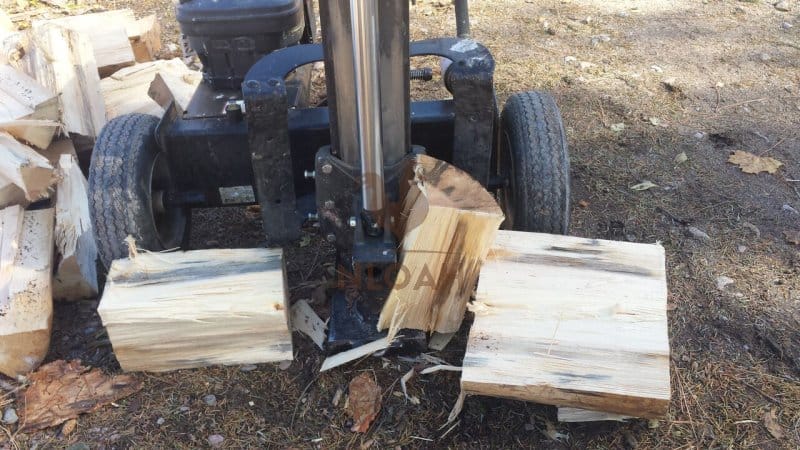
Depending on the exact model of wood splitter, you’ll put fuel into the fuel receptacle, oil in the oil receptacle and if it’s a hydraulic model you’ll have a canister of hydraulic fluid that you attach to the hydraulic unit.
Read your owner’s manual from cover to cover and understand all of the operational process of your wood splitter.
Follow all recommendations for proper operation and don’t use your wood splitter if you’re injured, ill, tired, or if you’ve been drinking alcohol. Keep in mind that your wood splitter is a machine and you should never operate any machinery when you’ve been using alcohol, or if you’re feeling ill or very tired.
Familiarize yourself with all of the controls that operate your wood splitter and make sure that any helpers understand how to safely operate and turn the machine off should there be any injury or need. Most wood splitters use a choke system.
If you’re going to operate your wood splitter in the vertical position, be sure to adjust the position before you start your wood splitter.
You’ll pull the cotter pin and flip the splitter to the vertical position. Be sure that it securely locks into place when you do this. Replace the cotter pin so that you won’t lose it. Now you can proceed to the next step to start your wood splitter.
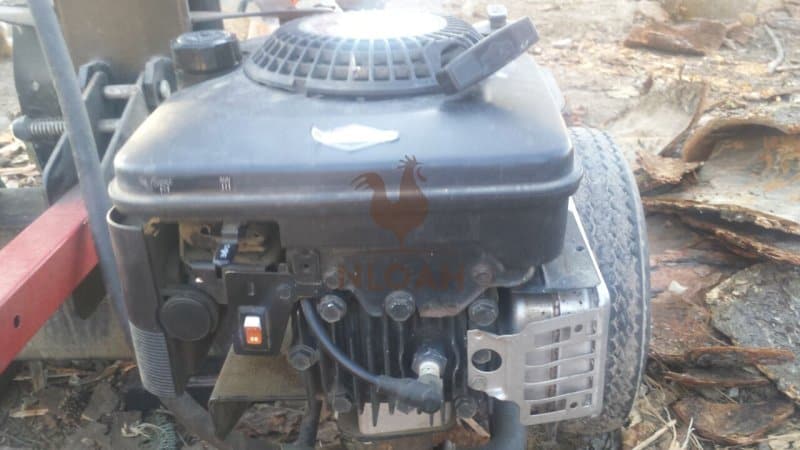
After you check your fuel, oil and hydraulic fluids you’ll flip the switch to the on position. Set the choke. Pull the starter pull and your wood splitter should roar to life. At this point in time you’ll adjust your choke. You’re now ready to operate your wood splitter.
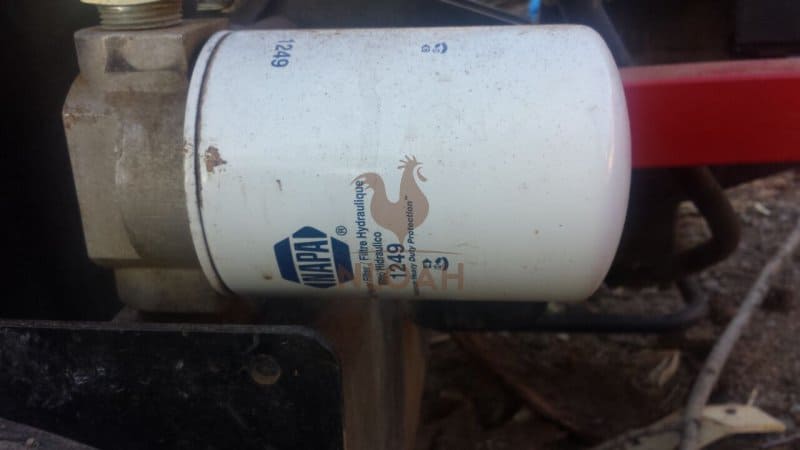
Checklist Prior To Starting Wood Splitter
Always have a check list that you go through before you begin operating your wood splitter. Check these items over before beginning any wood splitting session. Good check lists are as follows (be sure to design your own safety check list as required for your personal needs):
- Ensure that wood splitter is still on a flat surface.
- Ensure that fuel, hydraulic fluid, and oil are all properly filled.
- If wood splitter is electric ensure that the cords are all in properly working order and safely out of the way of operation.
- Check to ensure that all nuts and bolts and screws are securely tightened prior to starting the wood splitter.
Personal Safety
Disclosure: if you visit an external link in this post and make a purchase, I may earn a commission. Read my full earnings disclosure here.
Before you begin to use your wood splitter, you’ll want to consider your personal safety. Here are some considerations that you’ll want to use to keep yourself safe.
Steel toed boots or at the very least, enclosed toed shoes.
Work gloves to prevent splinters and tree sap from injuring or sticking to your hands.
If you have long hair, wear it back in a pony tail or clip it up.
Make sure that wrist watches or bracelets aren’t loose on the wrists as they could catch on something and cause injury. In fact, it’s recommended that you don’t wear any jewelry that could catch on anything while you’re operating the wood splitter.
Goggles are important to wear at all times. Bits of wood, saw dust and other particles can enter your eyes and cause injury if you’re not careful.
Long sleeves that don’t have big cuffs, bits of wood can flip up and injure your arms.
Keep fingers away from the maul when it’s in motion. Keep fingers away from any cracks on the wood as it’s splitting and ensure that you aren’t touching the log that is being split in any way, shape, or form, amputations can happen if you’re not extremely careful during this process.
Another person. If you’re splitting wood by yourself, you’re risking more injury. Having a second person there can go far in helping you to remain safe.
Another person can help you to roll larger rounds to the wood splitter. They can steady the wood and help watch for safety issues. If someone is injured, the second person can get help.
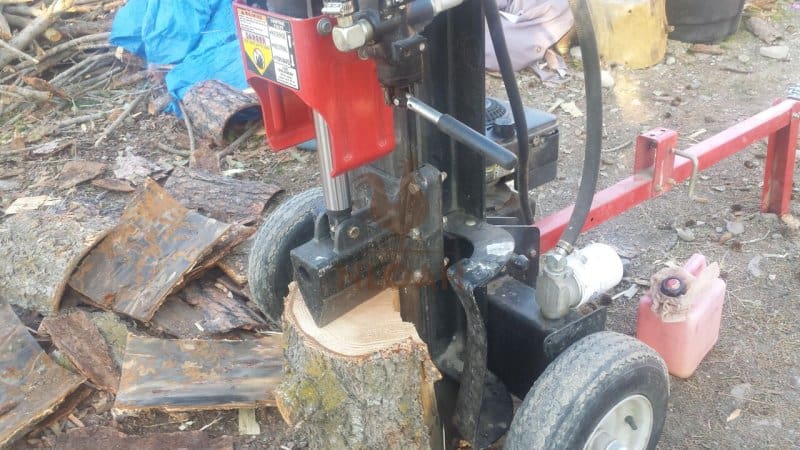
General Safety Tips For Operating Your Wood Splitter
Always take the time to read and understand exactly how the machine works and follow those instructions to the letter.
Understand how the controls work and know how to stop the machine quickly. Review the picture of the engine above and familiarize yourself with the on off switch.
Simply flipping to switch to the off position on a gas powered wood splitter will shut the machine off and you can then deal with any situation at hand that requires your full attention whether it be a stuck piece of wood or someone standing too close to the machine.
Always set your wood splitter on a flat surface where you don’t have to worry about it tipping over. Take the time to block it in so that if someone bumps it, the wood splitter won’t fall over or tip. Many wood splitters have wheels on one end.
Be sure to chock those wheels so that the wood splitter won’t move at all if it’s bumped or if a large piece of wood moves the wood splitter. A good sized rock is usually sufficient to chock the wheels or you can invest in a set of wheel chocks for your wood splitter.
Don’t allow children under the age of 16 to operate the machine. Before children over the age of 16 operate the wood splitter, ensure that they fully understand all of the proper operating procedures and that they understand how dangerous the wood splitter can be.
While it can save you a lot of time in splitting wood, it can also be a very dangerous piece of machinery.
Keep pets and other bystanders at least 20 feet from the machine at all times. Get into the habit that if someone gets too close, the machine is shut off until the person is far enough away for operation to be safe.
Remember that if the machine uses hydraulic fluid, and most do, that fluid escaping from even a pin hole can cause serious injury to your skin, if it penetrates your skin it can cause gangrene, blood poisoning or even death so wear gloves at all times and ensure that long sleeves are worn as well as long pants, proper foot wear and goggles.
Bits of wood in the eyes can hurt and even damage your vision. Don’t risk an eye injury by a shard of wood, wear your safety goggles while you’re using the wood splitter.
Never use your wood splitter for any other purpose than splitting wood.
Lock the machine into position either horizontal or vertical.
Only operate your wood splitter during daylight hours or under proper artificial lighting (in a garage or wood shed for example).
Use extreme care when refilling gasoline or oil and only fill these when the machine is off.
Never leave the machine running while you move a wheel barrow of wood or for any other reason. Take the time to turn it off if you’re leaving even for a moment.
Be aware that different types of wood split differently. If the log isn’t straight or if it has knot holes it may react differently. Be prepared to step back as the wood splits to ensure your own personal safety.
Never drink alcohol while operating the wood splitter. You need to keep your wits about you.
Only use the wood splitter when you’re alert and well rested. Just as any piece of machinery, injury can occur if you’re not paying close attention to what you’re doing.
Take plenty of rest breaks and if you have a larger piece of wood have someone help you lift it to ensure that you’re not injuring your back.
Always keep in mind, a good wood splitter will make quick work of splitting a piece of wood, just imagine what damage it can do to the human body if you’re not being mindful of how you’re using it at all times.
Always examine your log closely before you put it on the wood splitter. If branches are extending past the log, these should be cut flush with the round of wood before you put the piece of wood on the wood splitter. Also, keep in mind that your round needs to have a flat end in order to safely split it.
Keep your stance balanced when you operate your splitter, if you aren’t balanced you could fall and injure yourself as the log is splitting. Make sure that you have a flat level surface to stand on. Brush bits of wood out of the way as required while you’re splitting wood.
Ensure that there are no nails, or anything protruding from the wood as your splitting it. If a sign was nailed to a tree or post that you’re going to split, remove the nails first. When you split the wood these could become a projectile weapon and do serious damage to your person or anything else.
Understanding Your Wood
Keeping in mind that different types of wood burn differently, it’s also important to understand that some woods split easier than others. You’ll also have to factor in how wet the wood is. Wet wood is harder to split and will make the wood splitter itself work harder in order to split the wood.
Wet wood tends to be more fibrous when it’s split. The water prevents it from splitting easily and often there are areas where the wood is very rough and uneven. While you can still split wet wood, it’s going to be a bit more time consuming and definitely more dangerous as the wood doesn’t always split properly.
Wet wood also burns “dirty” and you’ll notice that it doesn’t heat up as quickly in your wood stove nor does it burn as clean. All of this is important in choosing which pieces of wood so split now and which ones to set aside and split later when they are drier.
If you are splitting wet wood or “green” wood, try to set it aside and stack it elsewhere so that it can season (dry out) for a time. This will help you to burn safer. The drier the wood is, the cleaner it will burn and the faster it will ignite.
Understanding Gas Powered Vs Electric Wood Splitters
There are different kinds of wood splitters. There are electric and gas and there are horizontal only styles as well as those wood splitters that are both horizontal and vertical. Here are a few important details about the various options.
Electric wood splitters require electricity to run. They’re great to have in your garage or wood shed as long as you have power to those locations.
Electric wood splitters tend to be available in mostly the horizontal only versions. If you’re going to be splitting rounds of wood that are over ten inches around, these aren’t usually powerful enough to use.
Electric wood splitters tend to cost less than a gas powered model that will work in both the horizontal and vertical positions.
If you’re only splitting a small amount of wood, electric wood splitters are an ideal choice and will work very well.
Keep in mind that electrical cords can fray, be damaged if they’re caught up in the wood splitter and that you need to make sure that the electrical cords remain dry even in inclement weather. If you’re unable to ensure any of this, don’t use the wood splitter on that particular day.
If at all possible, use an electric wood splitter under cover so that you won’t have to worry about such potential hazards with your wood splitter. Frayed cords can cause shorts and fires as well as serious personal injury.
If, however, you’re going to be using your wood splitter more frequently, for larger amounts of wood or even at the site that you go to in order to cut your firewood, you may wish to invest in a gas powered model that will work well just about anywhere.
Gas powered wood splitters tend to handle larger amounts of wood, especially if they can work in both the vertical as well as the horizontal positions. If you’re splitting more wood, this is likely the way that you’ll want to go.
Other features that wood splitters come with include traps for excess wood debris, self-cleaning mechanisms, dislodgers that will dislodge a piece of wood stuck on a maul, “tables” that will guide the wood into a wheel barrow as it’s split and more.
Just remember, the more features that you have on a wood splitter, the most costly the wood splitter is going to be when you purchase it.
Safety Tips If A Log Fails To Split Or The Wedge Doesn’t Cut
If a log fails to split it’s tempting to put it back and try again. Before you do this, ask yourself these questions and examine the piece of wood carefully:
- Is my splitter powerful enough to split this particular log?
- Is the wood too wet?
- Is my splitter able to accept this size of log (some splitters can only handle logs 10 inches and under).
- Is there a knot or limb in the way of the maul?
- Is the log in the correct position?
You may find that you have to set the particular piece of wood aside and manually split it. It’s not worth the danger of trying to force a piece of a log through a wood splitter and injuring yourself or someone else.
Always remember this and never force a piece of wood through the splitter if it’s not working. You could wind up damaging your wood splitter, injuring yourself or injuring someone nearby if you force a particular log into the wood splitter and it won’t work right.
If the maul wedge isn’t cutting ensure that the log is in the correct position. If it still won’t split the wood, turn the machine off and check to ensure that the wedge is sharp enough. If not, sharpen it with a file. Watch the maul for any nicks or burrs as well. Nicks and burrs could have a direct impact on how well the wood splitter maul is working to split your wood.
If a piece of wood becomes stuck on the maul, try moving the lever up or down to see if you can dislodge the piece of wood. Many splitters come with a special guard that will knock a piece of wood off of the maul as you move the maul into position.
If this doesn’t work, shut the wood splitter off before you attempt to remove the wood from the maul. This way, as you dislodge the wood you won’t accidentally injure yourself by the maul suddenly beginning to move.
While a manual log splitter is an ideal and economical way to cut and split logs that would take more effort with an ax, you must follow the proper safety protocols and tips to ensure that you’re safe at all times. Keep the above mentioned tips in mind at all times while you’re splitting your wood.
Ensure that you follow all of the proper safety procedures and avoid forcing anything. If something isn’t working right, always shut the wood splitter down before you ever begin to investigate the cause of the problem. This will prevent any accidental injuries from suddenly moving parts that could amputate fingers or toes or worse, kill someone.
A wood splitter is an invaluable tool on any homestead. It can save your back, upper arms and other muscles from being overworked. You can also get a lot more wood split in a single day when you use a wood splitter, than when you split your wood manually. Never use your wood splitter for any purpose other than to split wood. Following proper safety procedures is very important.
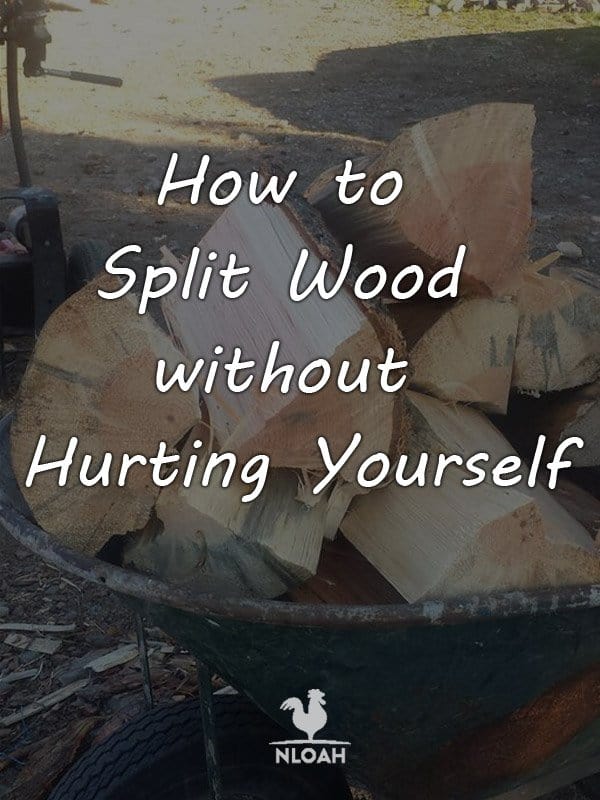

Hi, I’m Linda. I’m a mom, grandmother, homesteader. I love simple living and enjoy my life on a homestead where I garden, raise a variety of animals and strive for a life more like my grandparents lived.
My goal is to enrich life by living it as simply as possible and focusing on the way my grandparents did things. Life is so much more fun when it’s lived simply.

Very well written article , very informative , great writer